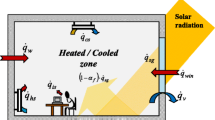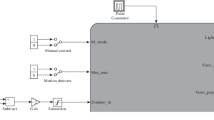Abstract
Building energy control strategies involve development of building energy models with appreciable accuracy. Several methods are available for model development and simulation. Present paper adopts resistance–capacitance network to develop a building energy model which is to be conditioned by a single-zonal heating, ventilation and air-conditioning (HVAC) system. A white box mathematical model is developed, based on the fundamentals of energy physics, in MATLAB/Simulink. Differential equations are formulated and modelled in state space form for a multi-layered building construction element. The element is configured as a three resistance and two capacitance model (pi-network) for a single-zonal room by considering the thermal resistance and thermal capacitance of the external walls, window glass, internal walls, ceiling and floor. Energy balance equations for each node of the 3R2C model are formulated as differential equations and solved when excited by step inputs. The input parameters for the developed model involve weather parameters of wind velocity, outdoor air temperature; thermos-physical properties of the building construction elements such as thermal resistance and thermal capacitance. The output parameter is the dry-bulb indoor air temperature for an input response of dry-bulb outdoor temperature and relative humidity. Developed modelling routine can act as benchmark for developing energy control strategies and their implementation.
Access this chapter
Tax calculation will be finalised at checkout
Purchases are for personal use only
Similar content being viewed by others
References
IEA Homepage. https://www.iea.org/topics/buildings. Last accessed 2020/11/23
US EIA. Available Online: https://www.eia.gov/todayinenergy/dtail.php?id=33252#:~:text=The%20United%20Nations%20projects%20India%E2%80%99s,consumption%20in%20India%20in%202015. Last accessed 2020/12/11
Harish, V.S.K.V., Parab, D., Doshi, K.: 11 building-to-grid integration for smart grids. In. Green Innovation, Sustainable Development, and Circular Economy, p. 157. Taylor and Francis, ISBN: 9780367441746 (2020). https://doi.org/10.1201/9781003011255
Harish, V.S.K.V., Kumar, A.: 10 smart energy control and comfort management in buildings. In. Green Innovation, Sustainable Development, and Circular Economy, p. 141, Taylor and Francis, ISBN: 9780367441746 (2020). https://doi.org/10.1201/9781003011255
Harish, V.S.K.V., Kumar, A.: Simulation based energy control and comfort management in buildings using multi-objective optimization routine. Int. J. Math. Eng. Manage. Sci. 5(6), 1324–1332 (2020). https://doi.org/10.33889/IJMEMS.2020.5.6.098
Harish, V.S.K.V., Kumar, A.: Reduced order modeling and parameter identification of a building energy system model through an optimization routine. Appl. Energy 162, 1010–1023, ISSN: 0306-2619 (2016). https://doi.org/10.1016/j.apenergy.2015.10.137
Mosaico, G., Saviozzi, M., Silvestro, F., Bagnasco, A., Vinci, A.: Simplified state space building energy model and transfer learning based occupancy estimation for HVAC optimal control. In: 2019 IEEE 5th International forum on Research and Technology for Society and Industry (RTSI), pp. 353–358. IEEE (2019)
Perera, D.W.U., Skeie, N.O.: Modeling and simulation of multi-room buildings (2016)
Fateh, A., Borelli, D., Spoladore, A., Devia, F.: A state-space analysis of a single zone building considering solar radiation, internal radiation, and PCM effects. Appl. Sci. 9(5), 832 (2019)
Underwood, C., Yik, F.: Modelling Methods for Energy in Buildings. John Wiley & Sons (2008)
Author information
Authors and Affiliations
Corresponding author
Editor information
Editors and Affiliations
Appendix
Appendix
Building envelope | Parameters | Values |
|---|---|---|
External wall | External wall area (m2) | 60 |
Thermal resistance (m2 °C/W) | ||
Rw1 = Rw21 | 0.36 | |
Rw2 = Rw12 | 1.65 | |
Rw3 = Rw13 | 1.25 | |
Thermal capacitance (J/m2 °C) | ||
Cw1 = Cw21 | 24,010 | |
Cw2 = Cw22 | 105,070 | |
Window glass | Window glass area (m2) | 16 |
Thermal resistance (m2 °C/W) | ||
Rg1 = Rg2 | 0.1785 | |
Thermal capacitance (J/m2 °C) | 33,810 | |
Ceiling and floor | Ceiling area and floor area (m2) | 120 |
Thermal resistance (m2 °C/W) | ||
Rc1 = RF1 | 0.04 | |
Rc2 = RF2 | 0.11 | |
Rc3 = RF3 | 0.27 | |
Thermal capacitance (J/m2 °C) | ||
Cc1 = CF1 | 24,010 | |
Cc2 = CF2 | 278,910 | |
Partition wall | Partition wall area (m2) | 40 |
Thermal resistance (m2 °C/W) | ||
RP1 = RP21 | 0.36 | |
RP2 = RP22 | 1.65 | |
RP3 = RP23 | 1.25 | |
Thermal capacitance (J/m2 °C) | ||
CP1 = CP21 | 24,010 | |
CP2 = CP22 | 105,070 | |
Other parameters | Volume of room (m3) | 500 |
Density of indoor air kg (m−3) | 1184 | |
Specific heat capacity of air (J/(kg °C)) | 1 |
Rights and permissions
Copyright information
© 2022 The Author(s), under exclusive license to Springer Nature Singapore Pte Ltd.
About this paper
Cite this paper
Singh, N.K., Harish, V.S.K.V. (2022). Single Zonal Building Energy Modelling and Simulation. In: Sahni, M., Merigó, J.M., Sahni, R., Verma, R. (eds) Mathematical Modeling, Computational Intelligence Techniques and Renewable Energy. Advances in Intelligent Systems and Computing, vol 1405. Springer, Singapore. https://doi.org/10.1007/978-981-16-5952-2_43
Download citation
DOI: https://doi.org/10.1007/978-981-16-5952-2_43
Published:
Publisher Name: Springer, Singapore
Print ISBN: 978-981-16-5951-5
Online ISBN: 978-981-16-5952-2
eBook Packages: Intelligent Technologies and RoboticsIntelligent Technologies and Robotics (R0)




